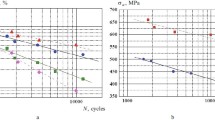Abstract
Fatigue crack growth rate, da/dN, of two high strength steels were examined in a laboratory air at different stress ratios, covering almost the entire range of stress intensity, ΔK, from nearly threshold value, ΔKth, to final fracture. The fatigue fracture toughness, ΔKfc, corresponding to the final fracture in fatigue, was also determined. The lower the ΔKfc, the higher da/dN and reduced ΔKth are revealed.
This correlation was analyzed quantitatively based on the four parameter Weibull function. And the stress ratio dependency of the fatigue crack propagation curve can be cleared in a successful manner.
The fatigue characteristic stress intensities, Ke and Kv, are proposed to define the transition behaviour in fatigue crack growth curve, from so called region 1 to 2, and from region 2 to 3, respectively. Especially the Kv valua can be specified to be the 0.63Kfc.
Résumé
On a étudié la vitesse de propagation de fissure en fatigue da/dN de deux aciers à haute résistance dans un atmosphère de laboratoire sous des sollicitations couvrant toute la gamme des intensités de contraintes variables ΔK, depuis une valeur voisine de la valeur du seuil ΔKth jusqu'à celle correspondant à rupture finale.
La ténacité à la rupture par fatigue ΔKfe correspondant à la rupture finale par fatigue a été également déterminée. II s'avère que plus ΔKfe est faible, plus élevée est da/dN et plus ΔKth est réduite. Cette correlation est analysée quantitativement en se basant sur la fonction de Weibull à quatre paramètres. On peut ainsi clarifier la manière dont le rapport de contraintes influe les courbes de propagation des fissures de fatigue.
On propose de définir pas les facteurs caractéristiques d'intensité de contrainte Ke et Kv les comportements de transition de la courbe de vitesse de propagation de la fissure entre respectivement les régions dénommées 1 et 2, et 2 et 3.
En particulier, on peut spécifier que la valeur Kv vaut 0,63 Kfe.
Similar content being viewed by others
References
T. Yokobori and T. Aizawa, Reports of the Research Institute for Strength and Fracture of Materials, Tohoku University, Sendai, Japan 6 (1970) 19–23.
T. Kawasaki, S. Nakanishi, Y. Sawaki, K. Hatanaka and T. Yokobori, Transactions of the Japan Society of Mechanical Engineers 41 (1975) 3324–3331 (in Japanese).
T. Kawasaki, S. Nakanishi, Y. Sawaki, K. Hatanaka and T. Yokobori, Engineering Fracture Mechanics 7 (1975) 465–472.
T. Kawasaki, T. Yokobori, Y. Sawaki, S. Nakanishi and H. Izumi, in Fracture '77, University of Waterloo Press, Canada 3 (1977) 857–864.
Y. Sawaki, T. Kawasaki, S. Nakanishi and T. Yokobori, Journal of the Japanese Society for Strength and Fracture of Materials 15 (1980) 173–177 (in Japanese).
Y. Sawaki, N. Aoyama and T. Kawasaki, International Journal of Fracture 26 (1984) 43–54.
S. Ishihara, I. Maekawa, K. Shiozawa and K. Miyao, Transactions of the Japan Society of Mechanical Engineers 50 (1984) 1677–1685 (in Japanese).
Y. Sawaki and T. Yokobori, Reports of the Research Institute for Strength and Fracture of Materials, Tohoku University, Sendai, Japan 19 (1973) 25–33.
G.E. Bowie and D.W. Hoeppner, in Proceeding of the Conference on Computer Simulation for Materials Applications, National Bureau of Standards, U.S.A. (1976) 1171–1178.
Y. Sawaki and T. Kawasaki, in Fatigue 84, Engineering Materials Advisory Services Ltd., U.K. (1984) 1193–1202.
C.J. Poon and D.W. Hoeppner, International Journal of Fatigue 1 (1979) 141–152.
S.J. Hudak, Jr. and R.J. Bucci, in Fatigue Crack Growth Measurement and Data Analysis, ASTM-STP 738 (1981) 321–356.
M.S. Miller and J.P. Galagher, ibid 205–251.
R.O. Ritchie, Transactions of the ASME, Journal of Engineering Materials and Technology 99 (1977) 195–204.
P.C. Paris and F. Erdogan, Transactions of the ASME, Journal of Basic Engineering 85 (1963) 528–539.
L. Guerra Rosa and C.M. Branco, in Fracture Prevention in Energy and Transport System, Engineering Advisory Services Ltd., U.K. (1984) 159–168.
R.O. Ritchie and J.F. Knott, Material Science and Engineering 14 (1974) 7–14.
R.O. Ritchie and J.F. Knott, Acta Metallurgica 21 (1973) 639–648.
Z. Nakai, K. Tanaka and R. Kawashima, Journal of the Society of Materials Science, Japan 33 (1984) 1045–1810 (in Japanese).
R.A. Schmids and P.C. Paris, in Progress in Flaw Growth and Fracture Toughness Testing, ASTM-STP 536 (1973) 79–94.
Author information
Authors and Affiliations
Rights and permissions
About this article
Cite this article
Sawaki, Y., Tada, S., Hashimoto, S. et al. Fatigue fracture toughness and crack propagation rate. Int J Fract 35, 125–137 (1987). https://doi.org/10.1007/BF00019795
Received:
Accepted:
Issue Date:
DOI: https://doi.org/10.1007/BF00019795




